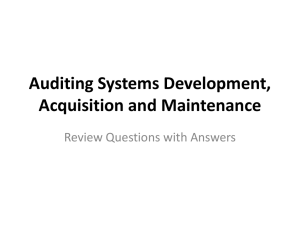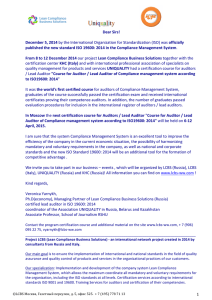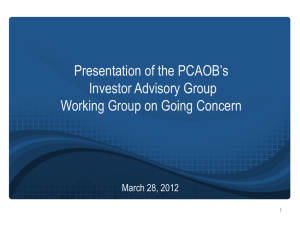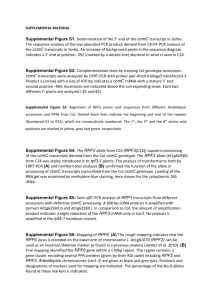Comments due January 31, 2011
advertisement
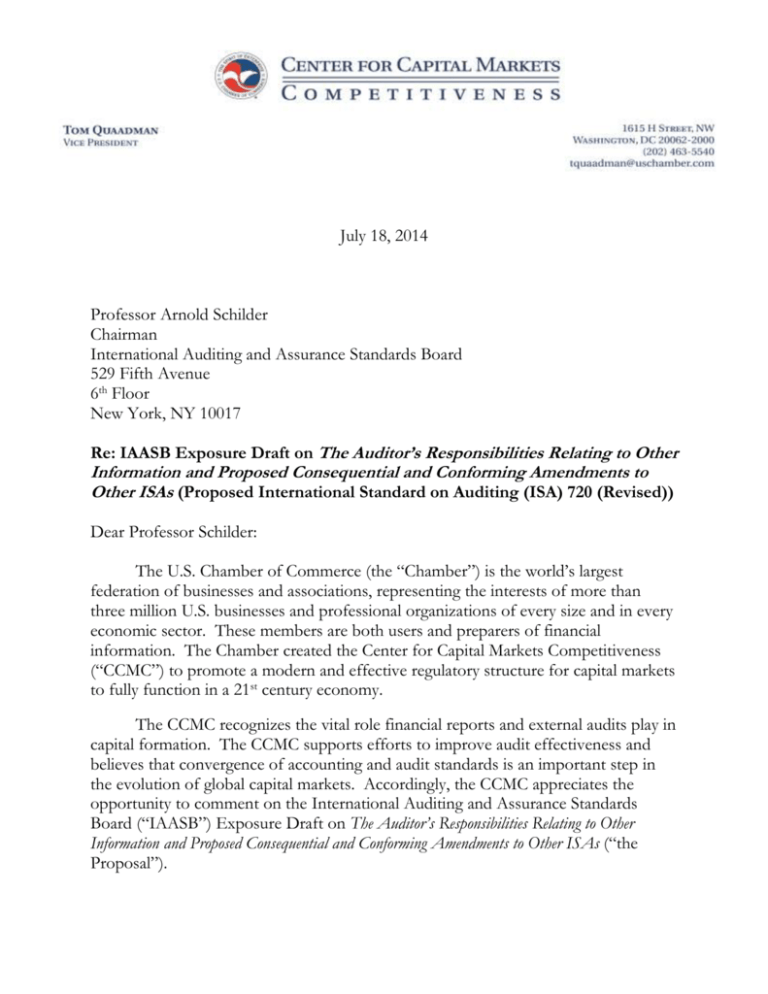
July 18, 2014 Professor Arnold Schilder Chairman International Auditing and Assurance Standards Board 529 Fifth Avenue 6th Floor New York, NY 10017 Re: IAASB Exposure Draft on The Auditor’s Responsibilities Relating to Other Information and Proposed Consequential and Conforming Amendments to Other ISAs (Proposed International Standard on Auditing (ISA) 720 (Revised)) Dear Professor Schilder: The U.S. Chamber of Commerce (the “Chamber”) is the world’s largest federation of businesses and associations, representing the interests of more than three million U.S. businesses and professional organizations of every size and in every economic sector. These members are both users and preparers of financial information. The Chamber created the Center for Capital Markets Competitiveness (“CCMC”) to promote a modern and effective regulatory structure for capital markets to fully function in a 21st century economy. The CCMC recognizes the vital role financial reports and external audits play in capital formation. The CCMC supports efforts to improve audit effectiveness and believes that convergence of accounting and audit standards is an important step in the evolution of global capital markets. Accordingly, the CCMC appreciates the opportunity to comment on the International Auditing and Assurance Standards Board (“IAASB”) Exposure Draft on The Auditor’s Responsibilities Relating to Other Information and Proposed Consequential and Conforming Amendments to Other ISAs (“the Proposal”). Professor Arnold Schilder July 18, 2014 Page 2 The CCMC is concerned about several aspects of the Proposal, specifically those related to the auditor considering other information (“OI”) and materiality. In its current form the Proposal will make financial reporting more complex, cloud material decision useful information for investors, and increase liability risk for auditors and businesses, all to the ultimate harm of investors. These concerns are discussed in more detail below. Background The CCMC has commented with other entities that have sought to expand the scope and role of the auditor. While we will discuss our concerns in greater detail, the CCMC also believes that our past comments are relevant to this proposal as well. Accordingly, we also attach to this letter, several comment letters which we respectfully request be included as part of the record and this comment letter.1 In those comment letters, the CCMC stated serious concerns with Public Company Accounting Oversight Board (“PCAOB”) proposals to expand the role of the auditor. Our comments stated that the PCAOB proposals would not address investor needs, would sow investor confusion by overlapping with other regulatory mandates, and blur lines of responsibility between auditors and businesses. We believe the same holds true with the Proposal before us today. If the Proposal is adopted in its current form, the CCMC believes that audit quality will be negatively impacted and capital markets will become less efficient leading to investor harm. I. Considering Other Information See attached the September 14, 2011 letter from the CCMC on the PCAOB Concept Release on Possible Revisions to PCAOB Standards Related to Reports on Audited Financial Statements and Related amendments to PCAOB Standards (PCAOB Release No. 2011-003, June 21, 2011, Rulemaking Docket Matter No. 034) and the December 9, 2013 letter from the CCMC on the PCAOB Proposed Auditing Standards – The Auditor’s Report on an Audit of Financial Statements When the Auditor Expresses an Unqualified Opinion; The Auditor’s Responsibilities Regarding Other Information in Certain Documents Containing Audited Financial Statements and the Related Auditor’s Report; and Related Amendments to PCAOB Standards (PCAOB Release No. 2013-005, August 13, 2013; PCAOB Rulemaking Docket Matter No. 034) . 1 Professor Arnold Schilder July 18, 2014 Page 3 Under the Proposal, auditors would be required to consider whether there is a material inconsistency between other information and the auditor’s knowledge obtained during the course of the audit. The Proposal states that OI involves financial and non-financial information (i.e., other than financial statements and the auditor’s report thereon), included in an entity’s annual report.2, 3 Furthermore, an Appendix provides examples of OI that include both qualitative and forward-looking (future-oriented) information. To illustrate, the Appendix states that OI includes “general descriptions of the business environment and outlook”, “overview of strategy”, “descriptions of trends in market prices of key commodities or raw materials”, “contrasts of supply, demand, and regulatory circumstances between geographic regions”, and “explanations of specific factors influencing the entity’s profitability in specific segments”.4 By all appearances, the role of the auditor would change into either that of a financial analyst or step into the shoes of management and become a permanent Monday morning quarterback. The CCMC does not support significantly extending the auditor’s responsibility for information outside the financial statements (and notes thereto) in this manner to encompass non-financial, subjective, opinion-based, and forward-looking information. Information of this nature is not necessarily fact-based or within the auditor’s purview and expertise. In addition to requiring the auditor to read and consider whether there is a material inconsistency between OI and the auditor’s knowledge obtained during the course of the audit, the Proposal also would require the auditor to remain alert for other indications that the OI appears to be materially misstated.5 We struggle to determine the difference between these two considerations and how the auditor would document these distinct considerations. Frankly, it appears that these See paragraph 1 (page 16) of the Proposal. The Chamber’s Global Risk and Governance Initiative sent a letter to the World Federation of Exchanges on the need to abide by materiality standard with non-financial disclosures. The letter can be found at: http://www.centerforcapitalmarkets.com/wp-content/uploads/2014/06/2014-6-25-UN-WFE-Sustainability-LetterFinal2.pdf 4 See pages 32-33 of the Proposal. 5 See paragraph 14(c) (page 18) of the Proposal. 2 3 Professor Arnold Schilder July 18, 2014 Page 4 requirements would make the auditor’s responsibilities unbounded and would significantly exacerbate litigation risk for both the auditor and the business. As a threshold matter, the CCMC strongly encourages IAASB to link the auditor’s responsibility for OI to whether there is a material inconsistency between OI and the financial statements and/or a material misstatement of fact. The CCMC would also like to emphasize that management is responsible for OI. In many jurisdictions, this responsibility is recognized via regulatory requirements. For example, the U.S. Securities and Exchange Commission (“SEC”) requires public companies to include a section on Management Discussion and Analysis (“MD&A”) in annual filings on Form 10-K. Among other matters, the SEC expects MD&A to provide a discussion of the business through the eyes of management and encourages this discussion to be in “plain English” and avoid boilerplate. The SEC has also made the explicit policy decision that MD&A is not subject to an audit. The CCMC is concerned that the Proposal, by significantly expanding the responsibilities of auditors for OI, would insert auditors much too deeply into areas of disclosure that are not their responsibility, but the prerogative of management. Thus, the Proposal may have the unintended consequence of changing the nature of the information disclosed by management and undermining the utility and evaluation features that OI provides for investors and other stakeholders, thereby compromising vehicles such as MD&A that regulators have deemed as an appropriate communication device between a business and its investors. II. Defining Material Misstatements of Other Information The Proposal defines an OI misstatement as OI that is incorrectly stated or otherwise misleading because it omits or obscures information necessary for a proper understanding of a matter.6 Focusing first on omitted information and in the context of the financial statements and notes, since a reporting framework provides the relevant criteria, omitted information is considered to be a financial reporting misstatement (i.e., financial information required by the financial reporting framework 6 See paragraph 12(b) (page 17) of the Proposal. Professor Arnold Schilder July 18, 2014 Page 5 that is inappropriately omitted). Thus, in the context of the financial statements and notes, the auditor’s responsibilities reasonably include completeness. However, it is our understanding that auditors are not currently responsible for completeness of OI. While this may not be the intent of IAASB, it appears that the Proposal in its current form would extend auditor responsibilities to the completeness of OI – even though criteria for making this determination are less defined or lacking. In addition, such an expansion would make auditors liable for a function that is management’s responsibility, and which is likely to often be beyond the auditor’s areas of expertise. Moreover, the definition of misstatements in the Proposal introduces a notion of obscured information directly into an auditing standard and in the context of OI where, again, criteria for making this determination are less defined or lacking. Thus, the meaning of obscured OI lacks clarity and we are concerned about the implications of this aspect of the Proposal. It could have dire consequences for businesses and auditors. Without a better understanding of what these consequences are we cannot support the Proposal in its current form. Importantly, considering these definitional issues related to misstatements in conjunction with the very broad notion of OI, as previously discussed (that includes qualitative, subjective and forward-looking information), makes auditor’s responsibilities for OI very problematic as proposed. Once again, among our concerns are that the Proposal will simply hold auditors responsible for OI after the fact and exacerbate litigation risks for auditors. Any such claim against an auditor will also likely trigger litigation against the company where no basis for doing so would otherwise exist. Such litigation will have a direct and indirect negative impact on shareholders making it more difficult for businesses to raise capital and be successful. Further, the Proposal explicitly defines a misstatement of OI as material if it could reasonably be expected to influence the economic decisions of users, recognizing that the OI is only part of the overall information available to users.7 The 7 Ibid. Professor Arnold Schilder July 18, 2014 Page 6 CCMC strongly recommends that IAASB delete this definition since it is one segment of information and does not adhere to the threshold measures of materiality. Instead, IAASB should ask auditors to look to the definition of materiality under the relevant financial reporting and/or regulatory framework, consistent with International Standard on Auditing 320. IAASB should not explicitly define materiality for financial reporting and disclosures within an auditing standard. For example, Auditing Standard No. 11 of the PCAOB recognizes that: In interpreting the federal securities laws, the Supreme Court of the United States has held that a fact is material if there is ‘a substantial likelihood that the … fact would have been viewed by the reasonable investor as having significantly altered the ‘total mix’ of information made available.’ As the Supreme Court has noted, determinations of materiality require ‘delicate assessments’ of the inferences a ‘reasonable shareholder’ would draw from a given set of facts and the significance of those inferences to him. … Overall, the CCMC is concerned that the Proposal represents a backdoor means of providing an auditor assurance for OI by implicitly making auditors responsible for such information “after the fact,” while providing for almost no incremental audit effort in doing so. Although we recognize that the audit report (when OI is obtained prior to the date of the auditor’s report) would state that “we have not audited the other information and do not express an opinion or any form of assurance conclusion thereon,”8 this statement would provide little protection from litigation given the definitions of OI and material misstatements and the nature of the auditor’s responsibilities for OI reflected in the Proposal. Conclusion The CCMC appreciates the efforts of the IAASB with this important project and the opportunity to comment on the Proposal. We believe that the Proposal in its current form has significant flaws as it will increase liability risk for auditors and businesses, obfuscate lines of responsibility between auditors and businesses and contribute to financial reporting complexity 8 For example, see paragraph A48 (page 28) of the Proposal. Professor Arnold Schilder July 18, 2014 Page 7 making it more difficult for investors to access decision useful information. While not the intent of the Proposal, the net effect of it will make capital markets less efficient and cause investors harm. Accordingly, we would request that our comments be taken into account and that the Proposal be reconsidered along these lines. Thank you for your consideration and the CCMC stands ready to assist in these efforts. Sincerely, Tom Quaadman

